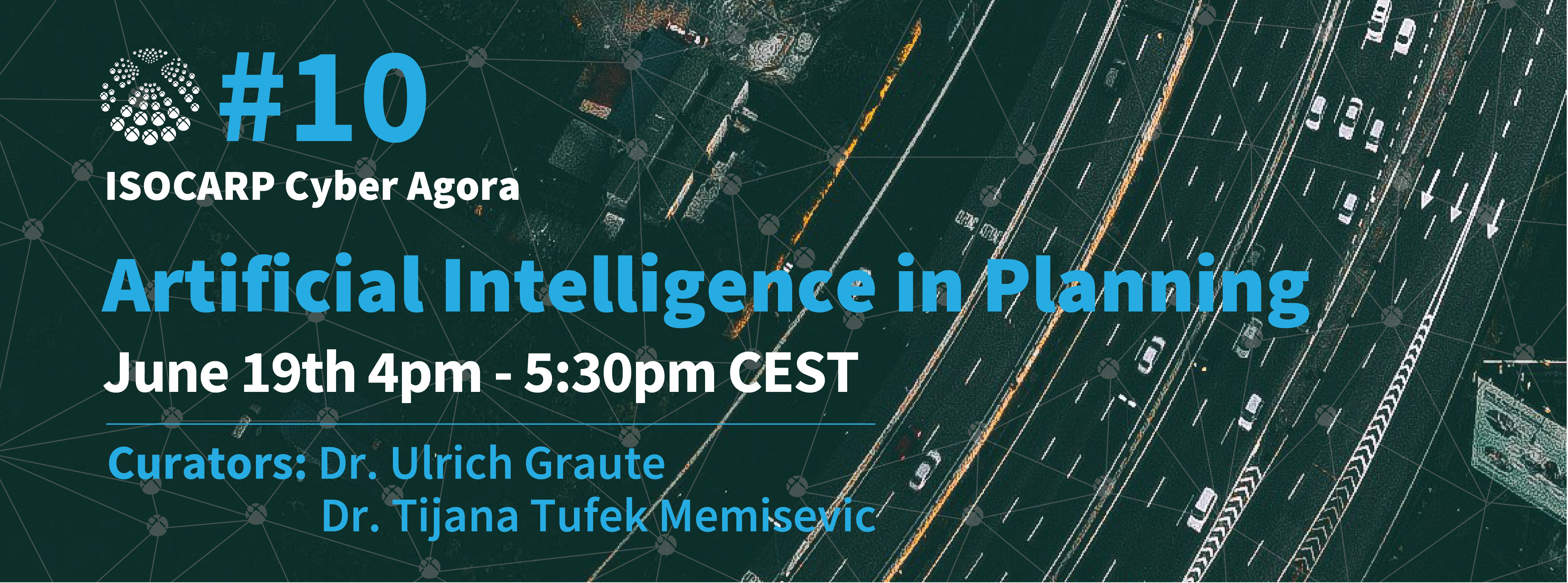
The International Society of City and Regional Planners (ISOCARP) is excited to invite you to this joint webinar, which will take place on June 19th 4pm – 5:30pm CEST.
Join us in this dialogue between practitioners, academics, and professionals worldwide.
We are looking forward to learning and reflecting on international best practices and research regarding the fast-developping Artificial Intelligence and its use in field of urban and territorial planning!
Background
From ancient philosophical inquiries on human intellect to cutting-edge innovations, the quest to create intelligence has spanned the ages. Today, Artificial Intelligence (AI) is rapidly becoming a pervasive aspect of the present and it is predicted by AI scientists like Stuart Russel of University of Berkeley, California to become the dominant technology of the future. The timeline and progress of this development is difficult to predict with certainty but we must plan for the possibility that machines will far exceed the human capacity for decision making in the real work. Gaining access to considerably greater intelligence would be the biggest event in human history. According to the AI scientist Stuart it is important to understand that ‘It also might be the last event in human history and how to make sure that it is not.’¹
The use of Artificial Intelligence in Urban Planning – a situation report
In recent years, the use of Artificial Intelligence (AI) in Urban Planning became a subject of discussion and research by numerous planning experts and institutions.².In 2022, UN-Habitat analyzed the Risks, Applications and Governance of “AI and Cities”³. According to UN-Habitat “The field of AI is growing at an unbridled pace. We are increasingly seeing AI systems leaving research settings to be deployed in almost all spheres of human activity. As a result, AI has the potential to profoundly transform the way our societies operate, including by supporting efforts on critical questions such as the climate crisis, public health, education and beyond. However, this ongoing societal transformation entails risks that must be addressed. There is an urgent need to develop responsible AI governance and practices across all scale levels of administrative and political organisations, in both the public and private sectors.”
The UN-Habitat report provides a first general framework on how to deploy AI responsibly in the context of cities and settlements. It is part of UN-Habitat’s strategy for guiding local authorities in realizing a people-centered digital transformation process in their cities and settlements. In doing so, other relevant literature has to be considered which has been published since 2022.
For instance, Chris Chiancone, Chief Information Officer at the City of Carralton writes in his paper of 20 June 2023 ‘Revolutionizing Urban Planning with Generative AI: A new Era of Smart Cities’: “At its heart, Generative AI is a type of machine learning that crafts new data instances reflecting its training set. Picture a master artist who, rather than simply duplicating a scene, employs their creativity to produce unique, lifelike outputs from a given input. That’s the magic of Generative AI, but in the realm of data. It’s the digital world’s virtuoso, wielding algorithms and computational power instead of brushes and pigments”.
Urban planning is a multifaceted field demanding the integration and scrutiny of a vast array of data. Traditionally, urban planners have had to manually sift through this data and make informed forecasts about future trends. This method is not only labor-intensive but also susceptible to human error and bias. Generative AI, with its prowess in analyzing large datasets and crafting realistic urban blueprints, provides a bridge to these hurdles. Furthermore, Generative AI can forecast urban expansion and optimize infrastructure planning.
The streets of InfiniCity, a model 3D city synthesis built using AI has as a goal to “automatically recreate lifelike real-world cities”, generated entirely from the imagination of a synthetic mind. According to Patrick Sission the author of the Bloomberg paper “What it looks like When AI Designs a City” it’s sort of a 3D vision of a ChatGPT-authored term paper that descends into made-up quotations and awkward grammar. The organic logic of real-world cities can’t quite be reduced to a SimCity-esque platform just yet. As mesmerizing as InitiniCity looks it is not very much appealing to live there. Several fictional examples created via programs like Midjourney can be found online. Meanwhile, city officials are beginning to wrestle with the relevance — and risk — of AI in urban governance.
In a nutshell, for Chiancone Generative AI brings a unique fusion of creativity and efficiency to urban planning. It’s akin to having a supercharged assistant that can process numbers, analyze data, generate models, and make predictions at a pace and scale that humans simply can’t compete with. All of this is done with the aim of creating more efficient, habitable, and sustainable cities.
The intersection of Generative AI and urban planning is a fascinating blend of technology and creativity. There are risks including ethical and data privacy considerations and there are technical limitations. Ensuring equitable outcomes, protecting individual privacy, and overcoming technical limitations are crucial tasks that require careful attention and thoughtful solutions. If well governed, it offers a potent tool for managing the complexity of urban environments, leading to smarter, more sustainable, and more equitable cities with a high quality of life. Cities that use digital technologies to enhance performance and wellbeing can pave their way for the creation of ‘smart cities’.
AI as developed until now is useful to create impressionistic image and artwork to facility imagination but it doesn’t generate blueprints. Patrick Sission describes that Zach Katz, who has deployed the technology to create more utopian versions of cities, is less concerned about the potential misuse of AI; to him, the explosion of AI-aided urban imagery reflects something healthier — an appetite for better places, and an avid desire to see cities remade with a little more intelligence.
Daniel Podrasa, Peter Zeile and Markus Nepp of the Karlsruhe Institute of Technology analyze in their paper “Machine learning for land Use Scenarios and Urban Design”. They discuss supervised and unsupervised machine learning algorithms and conclude that a supervised learning method, which they discussed with the example of Artificial Neural Network for classification, land-use scenarios can be generated and these can be used as a design basis for Generative urban design. However, the training of the Artificial Neural Network and the description for the land use for generating the training data is still a relatively time-consuming matter.
The proposed concept is not intended to replace the actual planning work in the sense of plan elaboration and plan realization; rather, we see it as a useful addition to be able to “explore” variants more quickly, better and more transparently and to be able to better grasp not only qualitative design work but also quantitative urban development designs. Used sensibly, it helps to be able to quickly examine variants at an early stage. Artificial intelligence is not intended to replace the planner’s profession, but to better prepare the basis for decision-making.” For a more specific analysis of the use of Generative AI in Urban Governance see Nelson, RJ. Naing, KM. Beroche, H. 2023. Generative AI for Urban Governance.
Objective
Purpose of this Cyber Agora is to discuss the use of AI in the context of urban and territorial planning and to do this from a planner’s perspective.
The primary learning objective of the Cyber Agora is to achieve a better understanding of opportunities and challenges related to the use of selected tools of AI. This will be done e.g. through the presentation and discussion of examples of AI use.
The session is addressed to a professional audience with an academic and/or practitioners background in urban and territorial planning. Familiarity with technical aspects of AI is welcome but not precondition.
Content
The Cyber Agora will be composed of three parts and moderated by Dr Tijana Tufek-Memisevic of the ISOCARP Board
Welcoming and introduction
Dr. Tufek-Memisevic, ISOCARP Board, Scientific Committee and DePaul University of Chicago
1.AI-based tools in urban design and planning of cities
Towards Predictive AI-Based Tools in Design and Planning of Cities
2.International standards, regulations and governance on AI
Could AI develop from a tool into a co-pilot of planning and how to keep control?
3.Panel discussion: The future of AI in planning
Curators

Dr. Ulrich Graute, Chair, ISOCARP Scientific Committee, Fellow at the Academy of Social Sciences AcSS

Dr. Tijana Tufek Memisevic, ISOCARP Board and Scientific Committee Member, Lecturer at DePaul University
Presenters

Thomas W. Sanchez, PhD, AICP – Professor, Texas A&M University

Dr. Li Fengqing – Vice Dean, Shanghai Institute of Urban Regeneration & Sustainability at Shanghai University

Prof. Dorota Kamrowska-Załuska, Gdansk University of Technology
Reflections by

Dr. Li Fan, Vice Chair, ISOCARP Scientific Committee

Dr. Wafa Al-Daily, ISOCARP Board Member, Women in Planning Leadership